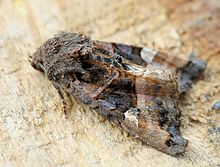Yellow-spotted forest shadow owl
| Yellow-spotted forest shadow owl | ||||||||||||
|---|---|---|---|---|---|---|---|---|---|---|---|---|

Yellow-spotted forest shadow owl ( Euplexia lucipara ) |
||||||||||||
| Systematics | ||||||||||||
|
||||||||||||
| Scientific name | ||||||||||||
| Euplexia lucipara | ||||||||||||
| ( Linnaeus , 1758) |
The yellow-spotted forest shadow owl or purple -lined owl ( Euplexia lucipara ) is a butterfly ( moth ) from the owl butterfly family (Noctuidae).
features
The moths reach a wingspan of 27 to 32 millimeters. Their front wings have a reddish-brown to purple-brown basic color. The middle field is dark and borders on the leading edge of the wing with a yellowish-white, often dirty, dark spot. The outer edge of the forewings is dark brown.
The caterpillars are about 35 millimeters long and are green or brownish in color. They have a very fine line of light strokes along their backs and only faintly recognizable, dark oblique lines on both sides. The animals have two small white dots on the eleventh segment.
Similar species
Occurrence
The animals are found almost everywhere and very frequently in Central Europe . They live in semi-shady to shady, often damp places such as forests , floodplains , moors and heaths , but also in parks and gardens.
Way of life
The moths can be attracted by both artificial light and bait.
Flight and caterpillar times
The yellow-spotted forest shadow owl forms one generation a year that flies from late May to late July. The caterpillars can be found from July to early October. Occasionally an incomplete second generation is also produced.
Food of the caterpillars
The caterpillars feed on a wide variety of herbaceous and woody plants, such as common worm fern ( Dryopteris filix-mas ), common hazel ( Corylus avellana ), great nettle ( Urtica dioica ), common clematis ( Clematis vitalba ), great balsam ( Impatiens) noli-tangere ), dock ( Rumex ), willowherb ( Epilobium ), ziesten ( Stachys ), celandine ( Chelidonium majus ), or blackberries ( Rubus fruticosus ).
development
The caterpillars are mostly nocturnal, but also eat during the day in bad weather. Pupation takes place in a chamber in the ground. The pupa hibernates.
swell
literature
- Heiko Bellmann : The new Kosmos butterfly guide. Butterflies, caterpillars and forage plants. Franckh-Kosmos, Stuttgart 2003, ISBN 3-440-09330-1 .
- Günter Ebert (Hrsg.): The butterflies of Baden-Württemberg Volume 8, Nachtfalter VI (Spanner (Geometridae) 1st part), Ulmer Verlag Stuttgart 2001. ISBN 3-800-13497-7
- Bernard Skinner: Color Identification Guide to Moths of the British Isles , Penguin UK 1999, ISBN 0-670-87978-9
- Michael Chinery: Parey's Book of Insects. A field guide of European insects. Publishing house Paul Parey, Hamburg u. Berlin 2004, ISBN 3-440-09969-5
Web links
- www.lepiforum.de Taxonomy and photos
- www.schmetterling-raupe.de
- Fauna Europaea taxonomy
- Moths and Butterflies of Europe and North Africa (English)
- Ian Kimber: Guide to the mots of Great Britain and Ireland (English)


